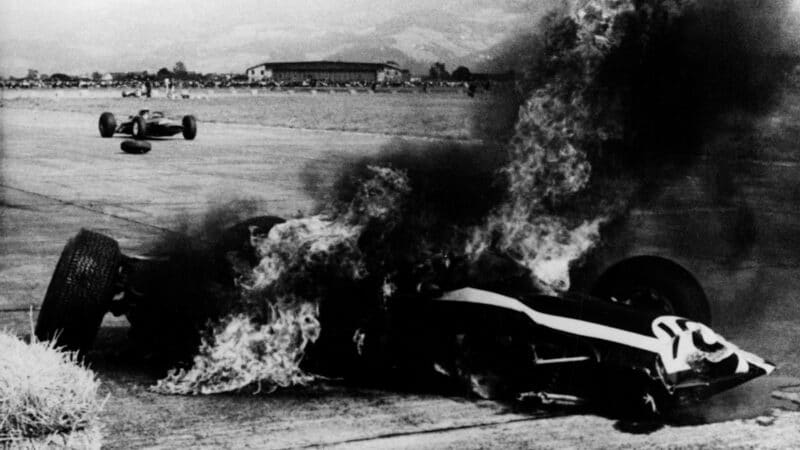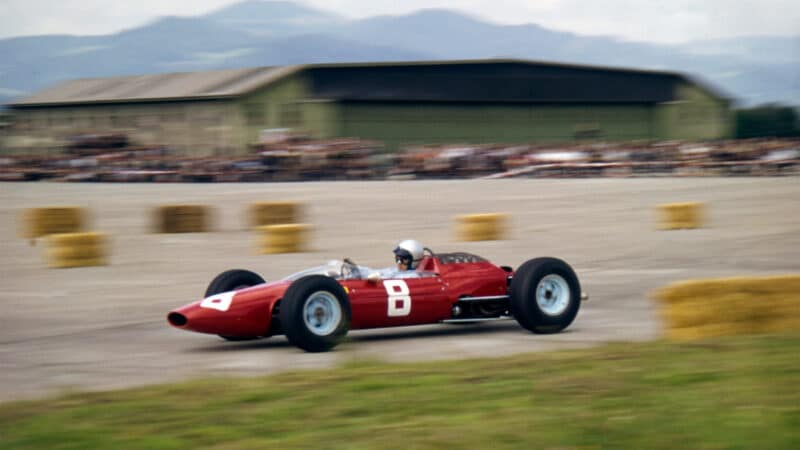After just nine of the scheduled 105 laps, three cars had suffered mechanical failures caused by excessive vibration — Amon’s Lotus-Climax (again), Graham Hill’s pole-winning BRM, and John Surtees’ Ferrari, which he had qualified alongside Hill’s BRM on the front row. The Ferrari had ground to a halt with partially collapsed rear suspension; Surtees, always a canny chap, realised that attrition would be high, so he walked briskly back to the pits, collected a jack, a set of spanners, and an armful of spares, walked briskly back to his stricken car, and set about trying to fix it. That he did, and he duly drove it slowly back to the pits. Sadly, his indefatigably competitive endeavours could not be rewarded, for the car was still too damaged to race. By all accounts he was delighted to go home, his journey made all the more pleasurable because he did it at the wheel of a Ferrari 330GT.
Next up, Trevor Taylor’s BRP-BRM suffered a suspension failure, shortly followed by halfshaft breakages for the Lotus-Climaxes of both Clark and Mike Spence. Soon after, Gurney’s leading Brabham-Climax was stopped by — yes, you guessed it — suspension failure, and a few laps after that Jochen Rindt, who was making his F1 grand prix debut, was disappointed but unsurprised to find that his Brabham-BRM’s steering had been shaken awry and was no longer operable. At half-distance only nine of the 20 starters remained, and, of those nine, two, Brabham’s Brabham-Climax and Innes Ireland’s BRP-BRM, had already been lapped by the leaders, having spent time in the pits for running repairs.
Phil Hill had seen the decimation all around and, both astute and wary, he began to sense that his Cooper-Climax was getting loose at the rear. Suspension failure? Yes, sir. As he exited Turn 3, Inner, his car sagged at the back and ran wide, hit the straw bales that marked the outside of the corner, and pirouetted to a stop, hurling its hapless pilot out of the cockpit as it did so. Hill was a bit bruised but otherwise unhurt — and, with hindsight, extremely lucky, for his car suddenly burst into flames. From a safe distance he stood and watched it burn to the ground.

Hill’s Cooper-Climax ablaze at Zeltweg
Getty Images
In the final quarter of the race a suspension radius arm broke on Mike Hailwood’s Lotus-BRM, but he nursed it back to the pits for repairs. Once they had been effected, out he went again, despite having lost 10 laps. Brabham was still toiling around at the back, too, 29 laps in arrears.
So who won? Here is how DSJ phrased that almost irrelevant detail in his Motor Sport report: “Lorenzo Bandini [Ferrari] was the winner of this strange race that had been characterised by reliability rather than driver ability.” Ginther (BRM) was the only other driver on the winner’s lap, and third, albeit three laps behind, was Bob Anderson, nursing his privateer Brabham-Climax at half-speed lest its already impaired driveshaft break entirely.








